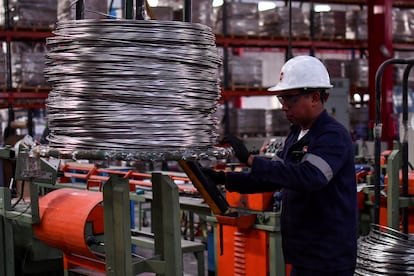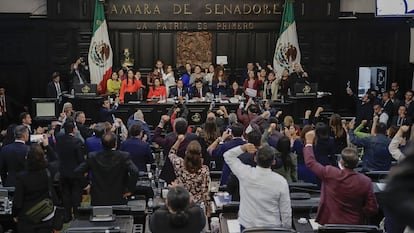A growing wave of uncertainty is freezing investment plans in Mexico, the United States’ largest trading partner, rattling domestic and foreign business leaders alike. Investors are weighing President Donald Trump’s decision to impose on August 1 — as the the plan stands — tariffs on Mexican-made cars, steel, aluminum, metal parts, and tomatoes. And they’re pondering Mexican President Claudia Sheinbaum’s push to overhaul the country’s judiciary in ways critics say undermine legal certainty and could roll back democratic gains.
No wonder they are increasingly unsure how to proceed. Plans to launch new operations in Mexico — or expand existing ones — are being reconsidered, postponed, or quietly shelved. The economic effects are increasingly rattling trade and investment decisions all along the U.S.-Mexico border, gnawing at executives’ confidence and potential job growth. Long term planning proves all but impossible, say business leaders and economic experts.
“Foreign investment is probably lower than it otherwise would have been at this point in the year,” said Tom Fullerton, an economics and finance professor at the University of Texas at El Paso. “It is still not clear whether the Trump administration is going to allow the U.S. to remain in USMCA. It is also not clear how the judicial landscape will change within Mexico.”
With many U.S. and Mexican businesses closely linked, the effects of the policy changes echo across the borderlands: U.S.-Mexico bilateral trade reached an estimated $840 billion in 2024.
Some 65,000 jobs have already been lost in Juárez alone, due to a myriad of factors, including increased factory automation, said Jerry Pacheco, president and CEO of the Border Industrial Association.
“We’ve lost at least three deals since the steel and aluminum tariffs went up to 50% in Santa Teresa, so it creates an uncertain business environment,” Pacheco said. “The U.S. and Mexico economies are so intertwined and dependant on each other that if U.S. companies are suffering because of steel and aluminum tariffs, Mexico is going to suffer also.”

The paralyzed decision-making threatens to weigh heavily on Mexico’s growth prospects — and on Sheinbaum’s legacy as the country’s first female president. The economy has already shown unmistakable signs of a sharp slowdown since late last year. No clear rebound is in sight on the border or beyond.
“Everything has been put on hold,” said Víctor González, owner of Solinda, a precision machine-manufacturing company based in the central Mexican state of Aguascalientes, referring to what he hears from colleagues and business associations. “One of the reasons is the reform of the judicial system. The other is tariffs.”
Initially, Trump’s sweeping threats to slap tariffs on all Mexican and Canadian imports forced business owners to recalibrate their south-of-the-border investment strategies. The renewed economic boom Mexico was expected to enjoy — fueled by Trump’s hardline stance on Chinese imports — quickly fizzled.
Rather than benefit from global supply chain shifts, both Mexico and Canada have found themselves caught in the trade-fueled crossfire. Rather than encouraging near-shoring, Trump decided to use tariffs as leverage to pressure both neighbors to crack down on the flow of migrants and drugs, particularly fentanyl.
An indication of possible impacts could be General Motors’ June announcement of a $4 billion investment in U.S. factories in Michigan, Kansas, and Tennessee. That fits the company’s strategy to revive its U.S. manufacturing footprint, which Trump has demanded.
GM revealed that the Blazer and Equinox, well-regarded sport utility vehicles that for years have been assembled in Mexico, will be built at plants in Tennessee and Kansas starting in 2027.
GM has made vehicles in Mexico since the 1930s, and its expanded production here was touted as an early victor for the free trade agreement between the U.S., Mexico and Canada in the early 1990s.
The automaker’s move was hailed by the Trump administration as a major victory. “No president has taken a greater interest in reviving America’s once-dominant auto industry than President Trump,” White House spokesperson Kush Desai said in a statement.
The U.S. administration’s message was clear to many observers — Mexico’s loss is America’s gain, even if GM must shoulder higher production costs that could lead to higher prices for consumers.
Though threats have eased as the year has proceeded — after Canada and Mexico announced border task forces and deployed more security personnel — investor confidence has been shaken.
Consequences of judicial reform
Now, Sheinbaum has realized her predecessor’s dream of radically reshaping Mexico’s judiciary, to the benefit of their all but hegemonic Morena political party. A scarcely attended election in June — turnout was just 11% — replaced career judges, magistrates, and Supreme Court justices with those chosen by popular vote.
Many fear that consolidating control over the courts will erode institutional checks and balances. With judgeships and other judicial posts dominated by ruling party loyalists, arbitrary or ideologically driven rulings may flourish, critics fear. All nine newly elected Supreme Court justices have ties to Sheinbaum, former president Andrés Manuel López Obrador, or their left-leaning party.
“What investors are looking for is certainty and rule of law,” said Tony Garza, U.S. ambassador to Mexico under the George W. Bush administration who now works on trade and other issues at Case and White, a law firm. “What they’re getting with tariff threats and judicial elections is chaos and incompetence.”
Many business leaders, economists, and credit-rating agencies fear the country is veering back toward the one-party rule that dominated Mexican politics for most of the 20th century.

The judicial reform could “negatively affect the investment appetite and business environment,” Fitch Ratings warned in a report last year. That echoed similar concerns voiced by S&P Global and Moody’s, the world’s other two largest credit-rating agencies.
The economic headwinds are already building, with warning signs on the border. Fullerton said unemployment rose from 2.2% in 2022 to 3.3% in 2024.
Across Mexico, with an annualized 2.7% economic contraction in the final quarter of 2024 and tepid 0.8% growth in this past winter, labor and public sentiment indicators also paint a troubling picture.
The private sector added little more than 85,000 new jobs between January and June — or more than two-thirds fewer than in the same period last year. That’s the lowest job creation since 2009, not counting the effects of the Covid pandemic, according to the Mexican Social Security Institute.
Consumer sentiment in June fell to a two-year low, while business confidence fell for a fourteenth consecutive month, according to the National Institute of Statistics and Geography (INEGI).
While overall foreign direct investment (FDI) remains positive, the inflow of new capital has all but stalled. Of the $21.3 billion in FDI Mexico received in the first quarter of 2025, just $1.58 billion — or 7.4% — represented fresh investment projects.
“The truth is, the way things are going — and with recent events like the judicial reform — many are saying this isn’t going to be good,” added González, the factory owner. “That’s more or less the feeling everywhere. Right now, it’s a perception, not yet a reality.”
That new foreign investment is well below the six-year average of 29% recorded during López Obrador’s administration, and it pales in comparison with the nearly 60% share of new capital the country registered at the beginning of this century.
At a recent meeting with business and political leaders from the Texas Lyceum, a nonprofit, nonpartisan statewide leadership organization, newly-arrived U.S. Ambassador Ron Johnson was put on the spot with the following question: What is the “purpose” of Trump’s tariffs? After a long pause, Johnson responded: Trump “is a businessman,” he said.
In the state of Texas alone, Mexican trade totaled $540 billion in 2024. “I sincerely believe […] he just wants things to be fair, reciprocal,” said Johnson, who said he is a “good friend” of the president. “He wants competition to exist on a level playing field.”
Amid an awkward silence, the moderator stepped in to thank the ambassador. Polite applause followed.
García reported from Mexico City. Corchado reported from Mexico City and the border, and Muela reoprted from El Paso.
Eduardo García established Bloomberg’s Mexico bureau in 1992 and served as its chief until 2001, overseeing the agency’s award-winning coverage in the country. In 2001, he embarked on a new venture by founding his own news organization, Sentido Común. @egarciascmx
Alfredo Corchado is the executive editor for Puente News Collaborative and the former Mexico/Border Correspondent for The Dallas Morning News. He’s the author of “Midnight in Mexico” and “Homelands.” @ajcorchado
Alyda Muela is a freelance journalist from El Paso, Tx. She is a senior majoring in multimedia journalism with a minor in general business at The University of Texas at El Paso. She is currently interning for Puente News Collaborative where she will be working on investigative, economic, and cultural stories. @alydamuela
Dudley Althaus has reported on Mexico, Latin America, and beyond for more than three decades as a staff newspaper correspondent. Beginning his career at a small newspaper on the Texas-Mexico border, Althaus had an award-winning 22-year stint as Mexico City bureau chief of the Houston Chronicle. He is also a Mexico correspondent for The Wall Street Journal. @dqalthaus
Sign up for our weekly newsletter to get more English-language news coverage from EL PAÍS USA Edition

